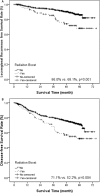Treatment outcomes and late toxicities of 869 patients with nasopharyngeal carcinoma treated with definitive intensity modulated radiation therapy: new insight into the value of total dose of cisplatin and radiation boost
- PMID: 26485757
- PMCID: PMC4742007
- DOI: 10.18632/oncotarget.5420
Treatment outcomes and late toxicities of 869 patients with nasopharyngeal carcinoma treated with definitive intensity modulated radiation therapy: new insight into the value of total dose of cisplatin and radiation boost
Abstract
This study was to report the long-term outcomes and toxicities of nasopharyngeal carcinoma (NPC) treated with intensity-modulated radiation therapy (IMRT). From 2009 to 2010, 869 non-metastatic NPC patients treated with IMRT were retrospectively enrolled. With a median follow-up of 54.3 months, the 5-year estimated local recurrence-free survival (LRFS), regional recurrence-free survival (RRFS), distant metastasis-free survival (DMFS), disease-free survival (DFS) and overall survival (OS) were 89.7%, 94.5%, 85.6%, 76.3%, 84.0%, respectively. In locally advanced NPC, gender, T, N, total dose of cisplatin more than 300 mg/m(2) and radiation boost were independent prognostic factors for DMFS and DFS. Age, T, N and total dose of cisplatin were independent prognostic factors for OS. Radiation boost was an adverse factor for LRFS, RRFS, DMFS and DFS. Concurrent chemotherapy was not an independent prognostic factor for survival, despite marginally significant for DMFS in univariate analysis. Concurrent chemotherapy increased xerostomia and trismus, while higher total dose of cisplatin increased xerostomia and otologic toxicities. In conclusion, IMRT provided satisfactory long-term outcome for NPC, with acceptable late toxicities. Total dose of cisplatin was a prognostic factor for distant metastasis and overall survival. The role of concurrent chemotherapy and radiation boost in the setting of IMRT warrants further investigation.
Keywords: chemotherapy; intensity-modulated radiation therapy; late toxicity; nasopharyngeal carcinoma; radiation boost.
Conflict of interest statement
There is no conflict of interest.
Figures



References
-
- Tuan JK, Ha TC, Ong WS, Siow TR, Tham IW, Yap SP, Tan TW, Chua ET, Fong KW, Wee JT. Late toxicities after conventional radiation therapy alone for nasopharyngeal carcinoma. Radiother Oncol. 2012;104:305–11. - PubMed
-
- Yeh SA, Tang Y, Lui CC, Huang YJ, Huang EY. Treatment outcomes and late complications of 849 patients with nasopharyngeal carcinoma treated with radiotherapy alone. Int J Radiat Oncol Biol Phys. 2005;62:672–9. - PubMed
-
- Sultanem K, Shu HK, Xia P, Akazawa C, Quivey JM, Verhey LJ, Fu KK. Three-dimensional intensity-modulated radiotherapy in the treatment of nasopharyngeal carcinoma: the University of California-San Francisco experience. Int J Radiat Oncol Biol Phys. 2000;48:711–22. - PubMed
-
- Lee N, Xia P, Quivey JM, Sultanem K, Poon I, Akazawa C, Weinberg V, Fu KK. Intensity-modulated radiotherapy in the treatment of nasopharyngeal carcinoma: an update of the UCSF experience. Int J Radiat Oncol Biol Phys. 2002;53:12–22. - PubMed
-
- Kam MKM, Teo PML, Chau RMC, Cheung KY, Choi PHK, Kwan WH, Leung SF, Zee B, Chan ATC. Treatment of nasopharyngeal carcinoma with intensity-modulated radiotherapy: The Hong Kong experience. Int J Radiat Oncol Biol Phys. 2004;60:1440–50. - PubMed
MeSH terms
Substances
LinkOut - more resources
Full Text Sources
Other Literature Sources
Medical

